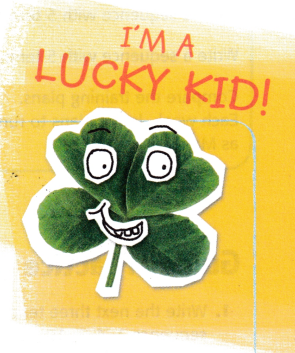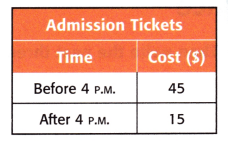All the solutions provided in McGraw Hill My Math Grade 5 Answer Key PDF Chapter 7 Lesson 6 Patterns will give you a clear idea of the concepts.
McGraw-Hill My Math Grade 5 Answer Key Chapter 7 Lesson 6 Patterns
A sequence is a list of numbers that follow a specific pattern. Each number in the list is called a term.

Math in My World
Example 1
Mary and her friends find a four-leaf clover during lunch. A four-leaf clover has four leaves. The table shows the total number of leaves for several four-leaf clovers. Extend the pattern to find the next three terms.


Each term in the sequence can be found by adding ____________ to the previous term.
16 + 4 = _________
_________ + 4 = ____________
__________ + 4 = ___________
The next three terms are ___________.
Answer:
20, 24, 28.
Explanation:
Each term in the sequence can be found by adding 4 to the previous term.
16 + 4 = 20
20 + 4 = 24
24 + 4 = 28
The next three terms are 20, 24, 28.
Example 2
Maria and Leong are training to run a half-marathon. A half ¬ marathon is about 13 miles. Their weekly training plans are shown in the table. Use the information to write a sequence to represent each person’s weekly training plan. Then compare the plans.

Each week, Maria will run two more miles and Leong will run four more miles than the previous week.
Write a sequence with 5 terms for Maria’s training plan. _____________
Write a sequence with 5 terms for Leong’s training plan. _____________
Compare the training plans. Each week, Leong plans to run ___________ as many miles as Maria.
Answer:
A sequence with 5 terms for Maria’s training plan is 2, 4, 6, 8, 10 .
Write a sequence with 5 terms for Leong’s training plan is 4, 8, 12, 16, 20.
Compare the training plans of both.
Each week, Leong plans to run 2 as many miles as Maria.
Explanation:
A half ¬ marathon is about 13 miles.
Maria and Leong are training to run a half – marathon.
Their weekly training plans are shown in the table,
with the help of the that we can compare both.
Maria weekly plan follows as,
Initial miles are 2.
Each term in the sequence can be found by adding 2 to the previous term.
2 + 2 = 4
4 + 2 = 6
6 + 2 = 8
8 + 2 = 10
Leong weekly plan follows as,
Each term in the sequence can be found by adding 4 to the previous term.
Initial miles are 4.
4 + 4 = 8
8 + 4 = 12
12 + 4 = 16
16 + 4 = 20
Compare the training plans of both.
Each week, Leong plans to run 2 as many miles as Maria.
Talk Math
How are the sequences 2, 5, 8, 11,.. . and 2, 6, 18, 54, . . . alike? How are they different?
Answer:
The sequences are alike in following the same number 3.
The sequences are different by adding and multiplying by 3.
Explanation:
In the sequences 2, 5, 8, 11,.. .
Each term in the sequence can be found by adding 3 to the previous term.
2 + 3 = 5
5 + 3 = 8
8 + 3 = 11
In the sequences 2, 6, 18, 54, . .
Each term in the sequence can be found by multiplying by 3 to the previous term.
2 x 3 = 6
6 x 3 = 18
18 x 3 = 54
Guided Practice
Question 1.
Write the next three terms in the sequence 1, 4, 7, 10, … .
Each term in the sequence can be found by adding ____________ to the previous term.
10 + 3 = ___________
_________ + 3 = ___________
_________ + 3 = _________
The next three terms are _________
Answer:
Next three terms are 13, 16, 19.
Explanation:
Each term in the sequence can be found by adding 3 to the previous term.
10 + 3 = 13
13 + 3 = 16
16 + 3 = 19
The next three terms are 13, 16, 19.
Independent Practice
Algebra Identify the pattern. Then write the next three terms in each sequence.
Question 2.
0, 7, 14, 21,…
Answer:
28, 35, 42.
Explanation:
Each term in the sequence can be found by adding 7 to the previous term.
21 + 7 = 28
28 + 7 = 35
35 + 7 = 42
Question 3.
1458, 486, 162, 54,…
Answer:
18, 6, 2.
Explanation:
Each term in the sequence can be found by dividing 3 to the previous term.
54 ÷ 3 = 18
18 ÷ 3 = 6
6 ÷ 3 = 2
Question 4.
72, 66, 60, 54…
Answer:
48, 42, 36.
Explanation:
Each term in the sequence can be found by subtracting 3 to the previous term.
54 – 6 = 48
48 – 6 = 42
42 – 6 = 36
Question 5.
1, 3, 9, 27…
Answer:
81, 243, 729
Explanation:
Each term in the sequence can be found by multiplying 3 to the previous term.
27 x 3 = 81
81 x 3 = 243
243 x 3 = 729
Question 6.
2, 4, 8, 16,…
Answer:
32, 64, 128
Explanation:
Each term in the sequence can be found by multiplying 2 to the previous term.
16 x 2 = 32
32 x 2 = 64
64 x 2 = 128
Question 7.
94, 88, 82, 76,…
Answer:
70, 64, 58
Explanation:
Each term in the sequence can be found by subtracting 6 to the previous term.
76 – 6 = 70
70 – 6 = 64
64 – 6 = 58
Question 8.
12, 24, 36, 48,…
Answer:
60, 72, 84
Explanation:
Each term in the sequence can be found by adding 12 to the previous term.
48 + 12 = 60
60 + 12 = 72
72 + 12 = 84
Question 9.
512, 256, 128, 64, …
Answer:
32, 16, 8
Explanation:
Each term in the sequence can be found by dividing 2 to the previous term.
64 ÷ 2 = 32
32 ÷ 2 = 16
16 ÷ 2 = 8
Question 10.
8, 13, 18, 23, . . .
Answer:
28, 33, 38
Explanation:
Each term in the sequence can be found by adding 5 to the previous term.
23 + 5 = 28
28 + 5 = 33
33 + 5 = 38
Question 11.
11, 24, 37, 50, . . .
Answer:
63, 76, 89
Explanation:
Each term in the sequence can be found by adding 13 to the previous term.
50 + 13 = 63
63 + 13 = 76
76 + 13 = 89
Question 12.
83, 75, 67, 59,…
Answer:
51, 43, 36
Explanation:
Each term in the sequence can be found by subtracting 8 to the previous term.
59 – 8 = 51
51 – 8 = 43
43 – 8 = 36
Question 13.
2, 8, 32, 128, …
Answer:
512, 2048, 8192
Explanation:
Each term in the sequence can be found by multiplying 4 to the previous term.
12 x 4 = 5122
512 x 4 = 2048
2048 x 4 = 8192
Problem Solving
Question 14.
An amusement park offers discounted tickets after 4 P.M. Both ticket prices are shown to the right. Write the total cost of 1, 2, 3, and 4 tickets for each time period. Compare the cost of 4 tickets before 4 P.M. to 4 tickets after 4 P.M.

Answer:
Cost of admission ticket before 4 P.M is 45, 90, 135, 180.
Cost of admission ticket after 4 P.M is 15, 30, 45, 60
Compare the cost of 4 tickets before 4 P.M. to 4 tickets after 4 P.M. is $120.
Explanation:
The chart tells us the cost of one ticket before 4 P.M and after 4 P.M
The difference between the prices of admission for a family of 4,
180 – 60 = $120
HOT Problems
Question 15.
Mathematical PRACTICE Which One Doesn’t Belong? Circle the sequence that does not belong with the other three. Explain your reasoning.

Answer:

Explanation:
The circle one shown above does not follow the sequence.
The other three follows the sequence of adding the same number to the previous number,
but the circle one adds the double of the existing number to the previous number.
2, 5, 8, 11 follows the sequence of adding 3 to the previous number.
4, 14, 24, 34 follows the sequence of adding 10 to the previous number.
7, 12, 17, 22 follows the sequence of adding 5 to the previous number.
But where as in the sequence 3, 6, 12, 24.. it follows as,
3 + 3 = 6
6 + 6 = 12
12 + 12 = 24
Question 16.
Building on the Essential Question How can we extend patterns?
Answer:
To extend the pattern means to use the pattern rule to write the numbers that would come next in the sequence.
First, notice that this is an ascending pattern meaning that it will involve addition, multiplication or both, subtraction or division.
McGraw Hill My Math Grade 5 Chapter 7 Lesson 6 My Homework Answer Key
Practice
Algebra Identify the pattern. Then write the next three terms in each sequence.
Question 1.
5, 10, 20, 40, ….
Answer:
80, 160, 320
Explanation:
Each term in the sequence can be found by multiplying 2 to the previous term.
5 x 2 = 10
10 x 2 = 20
20 x 2 = 40
40 x 2 = 80
80 x 2 = 160
160 x 2 = 320
Question 2.
63, 58, 53, 48, …..
Answer:
43, 38, 33
Explanation:
Each term in the sequence can be found by subtracting 5 to the previous term.
63 – 5 = 58
58 – 5 = 53
53 – 5 = 48
48 – 5 = 43
43 – 5 = 38
38 – 5 = 33
Question 3.
192, 96, 48, 24, …..
Answer:
12, 6, 3
Explanation:
Each term in the sequence can be found by dividing 2 to the previous term.
192 ÷ 2 = 96
96 ÷ 2 = 48
48 ÷ 2 = 24
24 ÷ 2 = 12
12 ÷ 2 = 6
6 ÷ 2 = 3
Question 4.
4, 11, 18, 25, …..
Answer:
32, 39, 46
Explanation:
Each term in the sequence can be found by dividing 2 to the previous term.
4 + 7 = 11
11 + 7 = 18
18 + 7 = 25
25 + 7 = 32
32 + 7 = 39
39 + 7 = 46
Problem Solving
Question 5.
Mathematical PRACTICE Make a Plan Dino’s Diner charges $4 for each sandwich. Carla’s Café charges $8 for each sandwich. Write the total costs of 1, 2, 3, and 4 sandwiches for each restaurant. Then compare the total cost of 4 sandwiches at each restaurant.

Answer:
$16
Explanation:
Dino’s Diner charges $4 for each sandwich.
Cost of 4 sandwiches is 4 x 4 = $ 16
Carla’s Café charges $8 for each sandwich.
Cost of 4 sandwiches is 8 x 4 = $32
Compare the total cost of 4 sandwiches at each restaurant.
$32 – $16 = $16
Question 6.
Luke always runs 1 lap to warm up for track practice. Alex always runs 3 laps to warm up for track practice. Write the number of total laps ran for 1, 2, 3, and 4 practices for each student. Then compare the total number of laps ran for 3 practices by both students.
Answer:
6 laps.
Explanation:
Luke always runs 1 lap to warm up for track practice.
Total laps ran for 4 practices is 1 x 4 = 4 laps
Alex always runs 3 laps to warm up for track practice.
Total laps ran for 4 practices is 3 x 4 = 12 laps
Then compare the total number of laps ran for 3 practices by both students,
9 laps – 3 laps = 6 laps.
Vocabulary Check
Question 7.
Fill in each blank with the correct word to complete each sentence.
A sequence is a list of numbers that follow a specific _____________.
Each number in the list is called a _____________.
Answer:
Pattern.
Term.
Explanation:
A pattern is a repeated arrangement of numbers, shapes, colors and so on.
The Pattern can be related to any type of event or object.
If the set of numbers are related to each other in a specific rule,
then the rule or manner is called a pattern.
Sometimes, patterns are also known as a sequence.
Terms are the values on which mathematical operations occur in an algebraic expression.
Test Practice
Question 8.
Which represents the next three terms in the sequence 8, 16, 24, 32, . …… ?
(A) 36, 40, 44
(B) 64, 128, 256
(C) 40, 48, 56
(D) 72, 216, 648
Answer:
Option (C)
Explanation:
Each term in the sequence can be found by adding 8 to the previous term.
The above sequence follows the multiplication table 8.
8 + 8 = 16
16 + 8 = 32
32 + 8 = 40
40 + 8 = 48
48 + 8 = 56